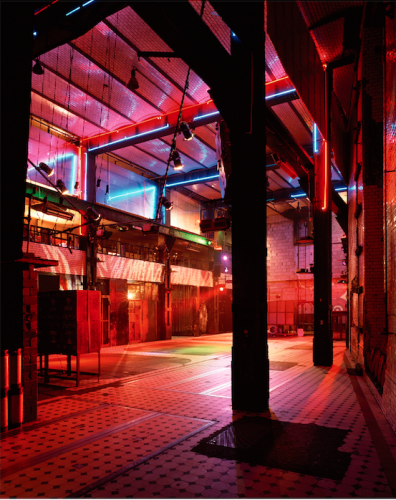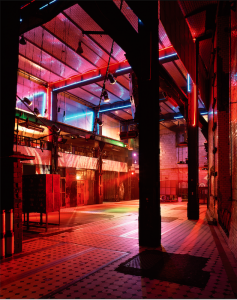
-
24
支持者
-
过期
活动结束日期2017年5月5日
CLUB BERLIN
an exhibition on electronic music and photography
柏林俱乐部
电子音乐文化与摄影展
CLUB BERLIN brings the impulses of Berlin techno to Chengdu.
Presented to engage both sight and sound, CLUB BERLIN features photographic works of Berlin’s 90s club scene by Martin Eberle. Together with music arranged by Berlin house and techno djs and footages from the Boiler Room.
Club Berlin 多媒体展览带着柏林Techno能量来到成都,这次展览包含了:视觉,声音与影像作品。我们将呈现由Martin Eberle拍摄的90年代柏林俱乐部的真实场景、Boiler Room 现场视频以及来自柏林的House和Techno DJ的音乐作品。
Curated by Heiko Hoffmann
策展人:Heiko Hoffmann
Heiko Hoffmann
is a German journalist, curator, lecturer and consultant. He's been editor-in-chief of Groove magazine, an industry-leading electronic music magazine, for the past 17 years. He’s also written for international publications such as Pitchfork, Spin and Sound & Recording (Japan) and hosted his own show Nightflight on German public radio station Fritz. Heiko has been a key-note speaker and panelist at festivals such as Sonar, MIDEM, ATP and ADE. He's a member of the board of advisers at Goethe institute and jury member of a number of international artist programs.
Heiko Hoffmann 是德国记者,策展人,讲师和顾问。他已经做了Groove 杂志,行业领先的电子音乐杂志,的主编辑17年。他还写了国际刊物,如Pitchfork,Spin和Sound&Recording(日本),并在德国公共广播电台弗里茨主办了自己的节目Nightflight。Heiko是Sonar,MIDEM,ATP和ADE等节日的主要演讲者和小组成员。他是歌德学院顾问委员会成员,还有一些国际艺术家计划的陪审团成员。
Berlin's club culture
Techno was the youth culture that united East and West in Berlin after the fall of communism in East Germany. After the Berlin Wall fell in 1989, unused plots of land and buildings were ready to be filled with new life by clubs, bars, galleries, workshops and studios. "All of a sudden, everyone was able to program their own world. With its DJing, producing, launching magazines and printing T-shirts, Techno was a kind of music that invited people to take part, a sound of flat hierarchies," as Felix Denk and Sven von Thülen write in their book The Sound of Family – Berlin, Techno and the Reunification. Berlin became the epicenter of a new club culture which attracted international attention – first with clubs like the Tresor and the E-Werk, and later with the Love Parade.
Techno是一个东德共产主义垮台后,融合东德和西德的青年文化产物。在1989年柏林墙落成后,未利用的土地和建筑已经准备好被俱乐部,酒吧,画廊,车间和工作室替代、充盈并重组了人们全新的生活方式。“突然之间,每个人都能够编程自己的世界,通过DJ,制作,发行杂志和印刷T恤等等方式,Techno是一种邀请人们参与的音乐,用一种平等层次的声音来对话。”「 引用Felix Denk 和 Sven von Thülen 的书 The Sound of Family – Berlin, Techno and the Reunification. (家庭的声音,柏林 Techno 和统一)」
柏林成为一个引起国际关注的新俱乐部文化的中心,最先诞生的俱乐部有:Tresor和E-Werk,随后还出现了Love Parade (鼎鼎有名的柏林街上派对)。
The club scene was given another boost at the beginning of the last decade. Thousands of Techno tourists were attracted into the city every weekend by cut-price European flights, a new wave of clubs like Bar 25, Watergate and the Berghain – and parties that never seemed to end. Artists, label operators, party organizers and promoters from all over the world moved to Berlin, constantly contributing new ideas for the city's sound – a development that continues to this day.
俱乐部场景在开始的十年里得到了迅速提振。每个周末,成千上万的Techno游客买了特价机票涌入柏林,新一轮的俱乐部开始诞生,如25号酒吧,Watergate和Berghain等,这些派对似乎永远不会停止。 来自世界各地的艺术家,厂牌运营者,派对组织者和推动者纷纷前往柏林,不断为柏林的声音贡献新的想法 , 这一发展一直持续到今天。
Martin Eberle – Temporary Spaces
摄影师 Martin Eberle – 临时空间
Photographer Martin Eberle, born in 1966 in Augsburg, moved to Berlin in 1992. He joined the team running the Galerie Berlintokyo venue and was soon using his camera to document the city's improvised clubs and well-hidden cellar bars. The photographs in the exhibition come from Eberle's book Temporary Spaces (published by Die Gestalten Verlag, Berlin 2001) and show examples of the nomadic club culture between 1996 and 2001.
摄影师Martin Eberle,1966年生于奥格斯堡,1992年搬到柏林。他加入了运行Berlintokyo艺术画廊的团队,并很快用他的相机记录了城市的临时俱乐部和地下酒吧。展览中的照片来自Eberle的“临时空间”(由Die Gestalten Verlag,2001年出版),展示了1996年至2001年间游牧俱乐部文化的例子。
Before professional, permanent, purpose-designed clubs like the Berghain or Watergate made such a big impression with integrated sound-and-lighting concepts and established Berlin's present-day reputation as a club metropolis, these venues exerted a huge influence on the reunited Berlin's image and made the city a magnet for DJs, musicians and other artists. There were new spaces for new music. Yet Eberle's photographs make a strangely alien impression on the people who were there at the time.
像Berghain或Watergate这样的俱乐部,是专业,稳定,并通过精心设计的,是完善的声音灯光系统的综合体,他们确立了柏林作为俱乐部大都会的当前声誉,这些场地对柏林的大众形象产生了巨大的影响 并使这个城市成为了吸引DJ,音乐人和其他艺术家的磁铁。这些都是新的空间和新的音乐。然而,Eberle的照片所诠释的角度和大众的印象是完全相异的。
The photographs of the interiors – some brightly lit, some dipped in colored twilight – show no partying people, no DJs or bar staff. "The venues seem so destitute and forsaken, completely robbed of their function, which is to create physical proximity, to generate a social framework for exhilaration," says Richard Kämmerling in a review for the FAZ newspaper. And yet it is precisely the emptiness of the rooms, especially seen in retrospect, that reveals their individuality. The clubs of the time took over empty and run-down workshops, banks, shops and power stations in East Berlin and redesigned them for their own purposes. Most of them were unrecognizable as clubs from the outside and by daylight. The decor was improvised. Decorating tables served as DJ consoles, light bulbs were covered with white underwear, the seats came from old GDR cafés.
所展示的照片 - 一些明亮的,浸在彩色的黄昏 ,没有显示任何派对的人,没有DJ或酒吧的工作人员。理查德·考默林(RichardKämmerling)在FAZ报刊的评论中说:“这些场地似乎如此贫穷和被遗弃,完全被剥夺了功能,这就是为了创造物理上的接近程度,创造出一个令人振奋的社会框架“。然而,恰恰是房间的空虚,特别是回想起来,揭示了他们的个性。当时的俱乐部在东柏林接管了空虚和倒塌的研讨会,银行,商店和发电站,并重新设计了自己的目的。他们中的大多数是无法识别的,因为来自外界和日光的俱乐部。 装饰是即兴的。装饰桌作为DJ控制台,灯泡上覆盖着白色的内衣,座椅来自旧的GDR咖啡馆。这些俱乐部和酒吧中的一些,像Monbijou大街上的103号,持续了不到一年,但他们永远刻在一代人的回忆中。
Some of these clubs and bars – like the 103 on Monbijoustrasse – lasted for less than a year, yet they became permanently etched on the memories of a whole generation. They were planned from the outset as a temporary use for buildings with unresolved ownership issues. Of the clubs shown today in the exhibition, only the E-Werk – Berlin's most spectacular club in the 1990s – is still used as a party venue; it can also be rented as a location for corporate events.
这些俱乐部和酒吧中的一些,像103 在 Monbijoustrasse,持续了不到一年,但他们永远刻在一代人的回忆中。他们从一开始就计划作为对未解决的所有权问题的建筑物的临时用途。在今天展出的俱乐部中,只有上世纪90年代柏林E-Werk - 柏林最壮观的俱乐部还在,它还能作为派对场地和也作为公司活动的地点出租。
The premises of Galerie Berlintokyo and the Sniper have long-since become part of the popular Hackesche Höfe tourist location; the Maria club and concert venue has been demolished, as has the old Tresor (the club itself has moved to a former power station in the borough of Mitte); and one of the city's biggest shopping centers now stands where international Techno acts like Underground Resistance or Aphex Twin once staged their first gigs in Berlin. Martin Eberle's photographs document the venues of Berlin's short-lived 90s club culture – places without which the city's current party scene would be inconceivable.
Galerie Berlintokyo和Sniper早已成为最受欢迎的HackescheHöfe旅游景点的一部分; Maria俱乐部和音乐会场地已经被拆除,老Tresor也被拆了,(现在的Tresor已经搬到了Mitte区的旧电站所在地); 而现在这座城市最大的一个购物中心也作为Techno的演出场地,像Underground Resistance和Aphex Twin,就在这里举办了他们在柏林的第一场演出。Martin Eberle的照片记录了柏林短暂的90年代俱乐部文化的场所,没有这些地方的柏林,如今的派对场景是不可想象的。
Boiler Room and DJ scene
Boiler Room parties have been taking place in Berlin since 2011. Invented in London, Boiler Room is a series of parties in which DJs and live acts play to a relatively small audience, but reach a global audience via a live internet stream. Up until early 2015, the Berlin Boiler Room was held literally in the basement boiler room of the Stattbad Wedding. The club has been closed in the meantime and the Boiler Room is celebrated at different venues in the city.
自2011年以来,柏林的Boiler Room一直在举办。Boiler Room是在伦敦发起的,它是系列的小型DJ和LIVE现场,但通过实时互联传播给全球的观众。2015年初,柏林Boiler Room就真的在Stattbad Wedding的地下室锅炉房里举办,之后Boiler Room不再有固定的场地,而是去到不同的城市,不同场地。
The parties themselves are for invited guests only – largely friends and fans of the participating DJs – and free of charge. They take place at weekdays starting at 8 p.m. and have little in common with the exuberance and uncontrollability for which Berlin's nightlife is famous. Where photography is otherwise banned, the audience here pose for the web cameras. The DJs play with their backs to the dancers so that they can be better seen; their sets rarely last longer than an hour, and the party is often already over at midnight. Nevertheless, the Boiler Room parties have quickly developed into an important part of the Berlin club culture.
派对本身是邀请制的 – 大部分是DJ的朋友和粉丝 – 也不收取费用。Boiler room 派对不是在周末,是在平时的晚上8点开始,与柏林的夜生活著称的繁荣和不可控制性几乎没有共同之处。观众不准备在现场拍照的,所以他们只能对着网络直播的摄影机抢镜。DJ们演出的时候会被背后跳舞的观众所包围, 所以他们都会被拍的很清楚,他们每个人演出的音乐很少持续时间超过一个小时,派对通常在午夜结束。然而,Boiler Room 派对已经迅速发展成为柏林俱乐部文化的重要组成部分。
This has less to do with the local parties than with the popularity of the advertising-funded live streams. Tens of thousands of participants all over the world follow the parties and discuss them in chat rooms or on Twitter. The archived podcasts of the parties on YouTube sometimes reach an audience of over a million; they have made Boiler Room one of the most important institutions of electronic club music.
现在根本无法控制有着商业赞助的网络传播。世界各地的成千上万的参与者都在观看Boiler Room的派对,并在聊天室或者Twitter上疯狂讨论。YouTube上的存档,有时浏览量达到百万以上,是他们使Boiler Room成为电子音乐俱乐部文化中最重要的机构之一。
The DJs themselves, who don't get paid for the parties, reach a lot more people with a Boiler Room party than with any festival appearance. They also get direct feedback about their sets, and sometimes attract the attention of international club bookers for the first time in this way. Boiler Room has long since established itself as a place where DJs present their new creations. International artists often also play at Berlin's Boiler Room parties, although the events are essentially a showcase for local DJs, live acts and labels.
参加Boiler Room 的DJ们是免费参与演出的,但是却比他们参加任何音乐节演出得到更多的关注。同时,他们也获得对他们音乐的直接反馈,有时也能以这种方式首次吸引到国际俱乐部预订演出者的注意。Boiler Room早已建立起自己作为DJ发表新作品的地方,各国的艺术家也经常在柏林的Boiler Room派对上演出,虽然这些活动本质上是针对本地DJ,Live演出和厂牌的。
The recordings of the Boiler Room sets that can be seen at the Zeitgeist exhibition range from Watergate resident La Fleur to Berghain's regular DJ Len Faki; from Discodromo, operators of the gay party series "Cocktail d'Amore," to footwork and bass DJ Sarah Farina; from House DJ Mano Le Tough from Ireland to the Berlin-based Italian Techno producer Lucy.
在Zeitgeist展览中可以欣赏到的Boiler Room sets的录音作品从Watergate resident La Fleur 到 Berghain's DJ Len Faki; 从Discodromo, 同性恋系列派对组织者 "Cocktail d'Amore," 到 Footwork 和 Bass DJ Sarah Farina; 从来自爱尔兰的House DJ Mano Le Tough 到 来自意大利但居住在柏林的 Techno 制作人 Lucy.
Today, the DJ scene in Berlin is more diverse and more international than ever. New producers and DJs are still constantly coming to Berlin to live in the city for at least a few months. They ensure that the sound in the clubs is constantly developing – even if House and Techno remain the styles that dominate the city's nightlife.
今天,柏林的DJ场景比以往任何时候都更加多元化和国际化。一些新的制作人和DJ仍然不断来到柏林,而且至少会住在这里一段时间。是他们确保了俱乐部的声音在不断的发展 - 即使House和Techno仍然支配着这个城市夜生活的风格。
Mixes from seven Berlin-based DJs can be heard continuously at the Zeitgeist exhibition and, together with the Boiler Room videos, give an acoustic impression of Berlin's current club culture. Among the music that can be heard are mixes of established acts – like Modeselektor from Brandenburg or the duo Tale Of Us, who have only been living in Berlin for a few years but have quickly become one of the internationally most sought-after House DJs – as well as relative newcomers like Answer Code Request, who publishes for Berghain's own label Ostgut Ton, or David August, who produces for labels like Innervisions and Diynamic.
我们可以在Zeitgeist展览中连续听到7个柏林DJ的混音,并与Boiler Room视频一起呈现柏林当前俱乐部文化的声音印象。可以听到的音乐是已经发表的作品,例如来自勃兰登堡的Modeselektor或Tale of us 二人组合,他们只住在柏林几年,但很快成为国际上最受欢迎的House DJ之一, 以及全新的Answer Code Request, 同时也是Berghain自己的标签Ostgut Ton的出版商,或者David August labels Innervisions 和 Diynamic 的制作人。
Club music has long-since become accepted by mainstream society – both in Berlin and in many other places of the world. But even if Berlin musicians such as Paul Kalkbrenner have long been working in the mainstream, and the city successfully uses its club culture for image marketing, there are still enough musicians doing new things and exploring niches.
俱乐部音乐早已被主流社会所接受,无论是在柏林还是在世界上的其他地方。但即使像犹如保罗·克尔克布伦纳(Paul Kalkbrenner)这样的柏林音乐人一直在主流音乐圈工作,即使柏林也一直用俱乐部文化作用于城市营销,但是,这里仍然有足够的音乐人持续在创造和探索新的可能。
Text: Heiko Hoffmann
Discounts
条款和条件
-
遵守法律
当使用造梦社服务时,用户同意遵守中华人民共和国(下称"中国")的相关法律法规,包括但不限于《中华人民共和国宪法》、《中华人民共和国合同法》、《中华人民共和国电信条例》、《互联网信息服务管理办法》、《互联网电子公告服务管理规定》、《中华人民共和国保守国家秘密法》、《全国人民代表大会常务委员会关于维护互联网安全的决定》、《中华人民共和国计算机信息系统安全保护条例》、《计算机信息网络国际联网安全保护管理办法》、《中华人民共和国著作权法》及其实施条例、《互联网著作权行政保护办法》等。用户只有在同意遵守所有相关法律法规和本协议时,才有权使用造梦社服务(无论用户是否有意访问或使用此服务)。请用户仔细阅读本协议并将其妥善保存。
-
项目筹款
造梦社是一个让用户(即“项目发起人”)通过提供回报向支持者筹集资金的平台。您作为项目发起人,社会大众可以与您订立合同,在造梦社创建筹款项目。您作为支持者,可以接受项目发起人和您之间的回报和契约,以赞助项目发起人的筹款项目。造梦社并不是支持者和项目发起人中的任何一方。所有交易仅存在于用户和用户之间。
-
通过造梦社的支持项目,您须同意并遵守以下协议,包括如下条款:
- 支持者同意接受在其承诺支持某项目时提供付款授权信息 。
- 支持者同意造梦社及其合作伙伴授权或保留收费的权利。
- 若因故须被退票,退票金额将被扣除使用第三方平台(微信、支付宝或网银以及接收短信所产生的费用)的2%
- 回报预期的完成日期并非约定实现的期限,它仅为项目发起人希望实现的日期。
- 为建立良好的信用和名声,发起人须按期完成项目的完整实施。
- 项目发起人可以在项目成功后直接向支持者要求额外信息。为了顺利获得回报,支持者须同意在合理期限内提供给项目发起人相关信息。
- 如活动难以进行或无法满足回报需求时,项目发起人可应支持者的请求而退款 。
- 项目发起人须满足项目成功后支持者的回报需求,或在无法实现的情况下退款。
- 项目发起人可随时取消或退款给支持者,退款完毕时,无须实现回报要求。
- 造梦社保留随时以任何理由取消项目的权利。
- 造梦社有权随时以任何理由拒绝、取消、中断、删除或暂停该项目。造梦社不因该行为承担任何赔偿。造梦社的政策并非评论此类行为的理由。
- 在项目成功和获得款项之间可能存在延迟。
- 项目费用:造梦社项目费用是5%。包括支付宝,信用卡和服务器费用。
- 项目发起人在收取款项后应根据支持者的要求开具正规票据,包括发票或收据。
造梦社不承担任何相关回报或使用服务产生的损失或亏损。造梦社无义务介入任何用户之间的纠纷,或用户与其他第三方就服务使用方面产生的纠纷。包括但不限于货物及服务的交付,其他条款、条件、保证或与网站活动相关联的有关陈述。造梦社不负责监督项目的实现与严格执行。您可授权造梦社、其工作人员、职员、代理人及对损失索赔权的继任者所有已知或未知、公开或秘密的解决争议的方法和服务。
-
项目发起人资格
- 已满18周岁的完全民事行为能力人。未满18周岁者请由监护人协助提供相关资料
- 中华人民共和国公民,或能提供长期在中国居住证明的非中华人民共和国公民
- 拥有能够在中国地区接收人民币汇款的银行卡或者支付宝账户
- 提供必要的身份认证和资质认证,根据项目内容,有可能包括但不限于:身份证,护照,学历证明等
- 造梦社的注册用户,已仔细阅读、同意并无条件接受造梦社用户协议所涉全部内容
- 其他根据项目发起、执行需求相关的必须条件
- 项目发起人需遵照《中华人民共和国行政许可法》第二十九条规定,应当向行政机关提出申请,取得相关部门批准后方可实施。
-
项目基本要求和限制
- 项目类别:
- 造梦社支持以下项目:科技,设计,影像,音乐,出版,人文,活动。
- 项目发起:
- 在项目发起和筹资过程中传达的信息是发起人本人真实的意思表示
- 发起人对项目内容以及项目文案的文字、图片和视频等内容应享有完整的知识产权,不得侵犯他人权利
- 发布、转载或提供的内容符合中国法律、社会公德和互联网社区秩序
- 项目在造梦社上线期间,不得在其他类似的众筹平台发布内容一致或相似的项目
- 使用由他人享有知识产权的内容时,应已获得相应权利人的许可或授权并做出署名
- 关于知识产权的特别友情提示:
- 在造梦社上发起的项目上线后,项目相关信息会被公开,发起人需预知公开的后果
- 当发起有关发明专利、实用新型、外观设计和商标等涉及工业产权的项目时,发起人应当事先做好相关权利保护
- 项目发起之禁止,包括但不限于以下条目:
- 禁止发起违反中华人民共和国法律法规和社会善良风俗的项目
- 禁止发起涉及股权分红、贷款还贷、利润分红、版权出售等类型资本运作相关的项目
- 禁止发起涉及政治、宗教和民族问题的项目
- 禁止发起满足个人物质需求的项目
- 禁止发起没有回报的项目
- 不接受项目和回报周期过长的项目
- 其他造梦社认为应当禁止发起的项目
- 项目回报:
- 项目必须根据支持的金额设置可执行的回报,包括实体回报或非实体回报
- 项目成功后,发起者必须按照承诺执行回报
- 关于项目回报内容的特别声明:
- 回报内容不得违反中华人民共和国法律法规和社会善良风俗
- 发起者对回报内容应享有完整、独立的处分权
- 得以股权、债券、分红、利息形式为回报
- 不得以食品作为回报
- 不得承诺夸张、难以实现的回报
- 不再接受
- 项目类别:
联系我们
- 关于网站上的问题:
support@zaomengshe.com - 关于活动的问题:
admin@zaomengshe.com - 其他的联系方式:
- 造梦社微博:造梦社
- 造梦社微信服务号:zmsevents
- 造梦社微信订阅号:zaomengshe
- 公司地址:成都市武侯区桐梓林北路2号凯莱帝景A座25楼E,邮编:610000
- 工作时间:周一至周五 09:30-17:30
确定想要放弃更改?









 支持者
支持者
 2017年5月5日 20:00
2017年5月5日 20:00







